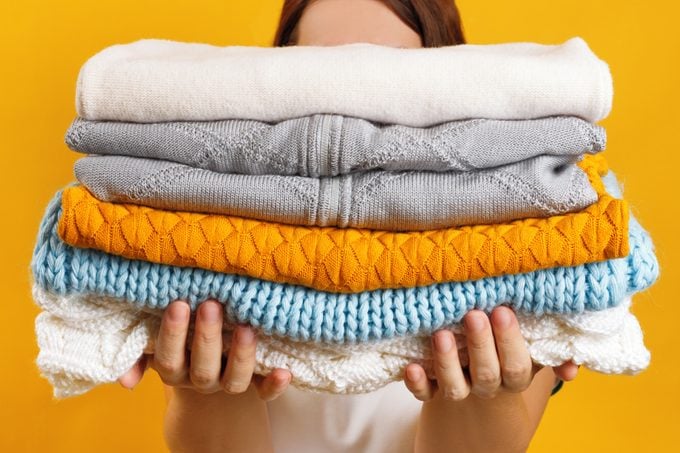I like to think of myself as a laundry expert, considering the amount of time and energy I put into stain removal, soaking and more. And drying? Forget about it! I know that wool dryer balls are little heroes, and I’m always careful to tumble-dry clothes on medium and remove them promptly.
So I’ve always assumed that air-drying is easier on my clothes, and when in doubt, things should be air-dried to preserve the fabric, use less energy and save on dry-cleaning costs. But despite people air-drying clothing for centuries, modern laundry rules are a little more nuanced, and I was surprised to find out that some items shouldn’t be dried this way.
To understand once and for all what clothing should and should not be air-dried, I turned to New York City–based laundry expert Jerry Pozniak, who has more than 40 years of experience in clothing care as the managing director of Jeeves New York. Ahead, you’ll find six common laundry items that Pozniak says should never be air-dried, a few that can be (but only in a very specific way) and yet another few you should always dry this way. Read on to save your clothes and other beloved items.
Get Reader’s Digest’s Read Up newsletter for more cleaning, humor, travel, tech and fun facts all week long.
Things you should never air-dry
Want to save time? Toss these items directly in the dryer instead of lugging wet clothes around to drip-dry on a drying rack, hanger or clothesline. Your back will thank you!
Towels and bath mats

According to Pozniak, there’s really no reason to air-dry towels, bath mats and other similar items. “Towels are going to take forever to dry, and there’s no practical reason why you wouldn’t use clothes dryers to speed that process along,” he says. “There’s no advantage to air-drying those items—in fact, it would be a disadvantage because of time and space.”
Plus, air-drying changes the texture of these types of items. “When garments are tumbled in a dryer, it softens them up a bit,” he explains. “When something is air-dried, it can stay stiff.”
So just toss ’em in the dryer … while following this pro tip: Dry towels and bulky bath items on medium to low setting. It will take longer, but the fibers will keep their softness.
Blankets and comforters
The same thinking applies to heavy items like blankets and comforters—it’s just not practical to air-dry something big and bulky in most cases. “Where would you hang it?” muses Pozniak. He says that it might be possible if you have a well-established clothesline outdoors and don’t live in an urban environment where dust and dirt can get to the items.
If your dryer can’t handle a big comforter, look for laundromats or laundry services that can help. You might have to bring a book, but they have machines that are built for large items.
Coats
Coats, like bedding, are often bulky and tough to get thoroughly dry. To make it easier on yourself, use a clothes dryer, particularly for items that contain down or down alternative materials. “You really need that fluffing action of the dryer tumbling the airflow through the feathers,” Pozniak says. Air-drying keeps the down feathers clumped together and changes the texture and feel of the item.
Toss in a few dryer balls to fluff up the fill, or use tennis balls.
Denim

How you dry denim depends on the fabric makeup. Some jeans are 100% cotton, and others are blended with synthetic materials like Spandex. Pozniak says to read the care label carefully, as it can “be your best friend.” If your denim is a blend, the garment label might suggest tumble-drying on low for a reason.
“You might want the practical advantage of machine-drying denim so that the cotton will shrink up a bit and then stretch out to fit you perfectly,” he says. Though if it’s raw or 100% cotton, you can stick to air-drying to reduce shrinking.
Another consideration is the color. The dyes used in some denim can cause “breaks” in the fabric when air-drying. Breaking happens when fabric folds or wrinkles, causing some areas to dry faster than others. This changes the look of a garment. “Denim dye can be fragile,” he says. In addition, air-drying can cause some dyes to drip, which is not something you want to deal with on your floor.
Things you can air-dry, with restrictions
Air-drying is gentler on clothing, and even though it takes longer, it will help your stuff last longer. But it’s important to air-dry your clothes the right way to keep them looking great. Here’s what you can air-dry, with a few tips from our pro.
Knits

Before deciding whether to toss you sweaters in the dryer, know that the fabric makeup is important—so check the label. Many sweaters are now made from synthetics like acrylic, and they stretch like crazy when they’re wet. Hanging them vertically to dry, such as on a drying rack, could do more damage than you think. Instead, Pozniak suggests air-drying acrylic knits about 90% of the way before giving them a short spin in the dryer to soften them up.
To air-dry knits properly, wring them out and lay them flat on a clean, dry towel. Pozniak says mold shouldn’t be an issue in most cases, as it takes 48 hours in a temperature above 75 degrees Fahrenheit for mold to form.”You’d have to take something really wet, put it in a plastic bag and leave it in a hot room for a couple of days [for mold to form],” he says. “No mold is going to occur during proper air-drying, and most things will air-dry overnight.”
Embellished items
Here’s another one where it’s best to check the label. It might feel intuitive to air-dry your hand-washed embellished or beaded items, and you’re right … but there are some caveats, says Pozniak. Embellished items are persnickety and need a lot of attention to prevent damage. “If something embellished is too wet and you air-dry it by hanging it from the shoulders, you’ll stretch it out, or you could tear the fabric or ruin the embellishments,” he says.
If you’ve hand-washed an embellished item at home and need to air-dry it, he recommends doing it flat, laying out the item with enough room to breathe, such as on a table. The drying process can take a long time. All the “rules” to remember for embellished items might “start to make you a little crazy,” so he recommends seeking professional help for special, delicate items.
What items should you always air-dry?
Most of the world uses air drying as the sole method to dry clothes, Pozniak points out, and he’s a big fan of air-drying for most items. However, some items should always be air-dried, even if the label allows for dryer use.
Wool and cashmere

Pozniak says that wool shouldn’t be washed in a machine and should be washed by hand, and only when absolutely necessary. Likewise, while many cashmere garment labels say “dry-clean only,” Pozniak says hand-washing most of them should be OK—but never wash cashmere in a washing machine, as the fibers are too delicate.
If you’ve made a mistake and washed a wool item, you should air-dry it. “The heat of drying will cause wool to shrink, and you’ll end up with something felted, which is where the wool retracts dramatically,” he says. This is because the barbs on the fibers compact, and no amount of stretching will bring them back without tearing the fibers. Instead, lay it flat to dry on a clean, dry towel in a well-ventilated area, flipping it halfway through.
For cashmere, he says to wring it out well and lay it on a clean towel. Then, roll up the item in the towel, gently squeezing out additional moisture. Get a clean, dry towel, and leave the cashmere to dry flat after reshaping it to your liking.
Silk
Silk should also be hand-washed, although some labels might say that machine-washing in cold water on a delicate cycle is fine. Don’t put silk in the dryer, as the delicate fibers can break easily and the item can shrink. Pozniak says breakage, or fabric discoloration, can occur if you’re not paying close attention to a silk item.
To dry silk properly, gently press the excess water out of the item—don’t wring it or roll it up–and shake it to release additional moisture. Lay it flat or hang it by its hem, keeping it out of direct sunlight.
Synthetic workout gear
Finally, Pozniak says anything synthetic that’s performance-based should be air-dried, as heat can mess with the fabric structure. He air-dries his workout apparel to ensure that it keeps working the way it’s supposed to.
Air-drying inside versus outside
If possible, Pozniak prefers air-drying outside. “There’s nothing quite like an item that has been dried outdoors. It’s the most economical and environmentally friendly way to dry clothes, and they also just smell really nice,” he says.
When air-drying inside, he says it’s important to keep an eye on your items. While mold is not likely to happen, spaces that aren’t well-ventilated or that have high humidity could mean long drying times—and more attention on your part to replace wet towels and flip items.
He also says to keep in mind that items drying inside a home without access to a breeze might get stiff. In that case, if the care label says it’s OK, you might want to toss them in the dryer for the last 20 minutes or so on low to soften them up.
Tips to air-dry your items properly
- Read garment labels carefully.
- Remove as much excess water as you can before hanging an item or laying it flat to dry.
- Replace towels under flat items frequently, and remember to flip the garment halfway through.
- Air-dry outside, or make sure you have a well-ventilated area to speed up drying time.
- Avoid direct sunlight on bright or dark clothing.
- Dry smelly items outside.
- Don’t put away an item until you are sure it is 100% dry.
RELATED:
- You’re Probably Not Cleaning This Part of Your Washing Machine, but You Really Need To
- This Is the Only Washing Machine Cycle You Need to Use, According to a Laundry Expert
- The One Laundry Mistake Almost Everybody Makes—And Why It’s a Bigger Problem Than You Probably Think
About the expert
|
Why trust us
At Reader’s Digest, we’re committed to producing high-quality content by writers with expertise and experience in their field in consultation with relevant, qualified experts. We rely on reputable primary sources, including government and professional organizations and academic institutions as well as our writers’ personal experiences where appropriate. We verify all facts and data, back them with credible sourcing and revisit them over time to ensure they remain accurate and up to date. Read more about our team, our contributors and our editorial policies.
Source:
- Jerry Pozniak, managing director of Jeeves New York and co-author of The Laundry Book; interviewed, August 2025
The post 6 Things You Should Never Air-Dry—And What Could Happen If You Do appeared first on Reader's Digest.
from Reader's Digest https://ift.tt/cJNrxw8



Comments
Post a Comment